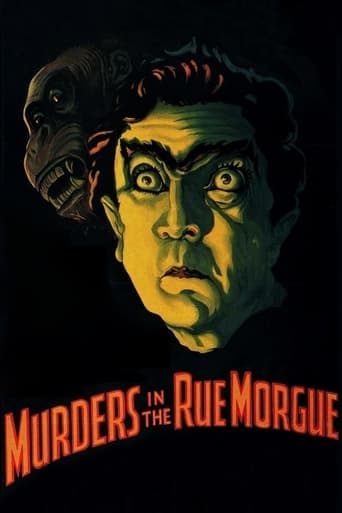alexanderdavies-99382
"Murders in the Rue Morgue" has been rather unfairly regarded over the years. It's actually quite difficult to judge this film as 15 minutes of footage was removed before the film went out on general release in 1932.Bela Lugosi steals the film as the crazed scientist. The supporting cast ranges from being tolerable to downright poor.Director Robert Florey was offered "Murders in the Rue Morgue" as a consolation prize after being removed from the 1931 "Frankenstein" movie.According to various sources, "Murders in the Rue Morgue" didn't satisfy Florey half as much as "Frankenstein" would have. Be that as it may, the above film has many effective scenes and is quite violent for 1932. The photography is outstanding as the cameras roam along the streets that represent 1840s Paris. The atmosphere is well sustained throughout. The comedy interludes are CRINGEWORTHY though. There is simply no place for it in this film. However, the damage is minimal.The film works itself to a thrilling climax.
MissSimonetta
Murders in the Rue Morgue (1932) certainly fits the "style over substance" classification. Unlike some others, I would not call it an underrated masterpiece, but for what it is, it's not a bad film. Bela Lugosi hams it up big time while Sidney Fox and Leon Ames are pretty to look at but bland as the lovers brought into peril by Lugosi's plans to mate humans and apes.The expressionistic sets are beautiful and the mood is creepy. There is one genuinely creepy scene where Lugosi tortures a kidnapped street walker until she dies. The climactic chase with Erik carrying the unconscious damsel-in-distress across the rooftops is an obvious homage to the German horror classic, The Cabinet of Dr. Caligari (1920).Of course, there is a degree of silliness with the ape, Erik. In some scenes, it is quite obvious we're watching a man in a suit stomping and hopping about.No great film, but fans of 1930s horror will eat it up.
mhesselius
I saw "Murders in the Rue Morgue" when I was just a child in the sixties and wasn't impressed. But now that I've seen the uncut original on Universal's Lugosi collection, I believe "Murders" is one of the most under-rated films from the golden age of horror.Direction by Robert Florey, cinematography by Karl Freund, and art direction by Charles Hall will satisfy the cravings of atmospheric horror fans. And the sources that Florey uses—the Poe story and the silent classic "The Cabinet of Dr. Caligari"—dovetail nicely. What seems rather silly in the Poe story (an ape escapes from a sailor to commit senseless murder) is more plausible and horrific when the ape's owner becomes Dr. Mirakle, a mad scientist intent on proving humans and apes are evolutionary cousins. Why else inject ape's blood into nubile young women if not to find a suitable mate for his side show attraction Erik? I was also impressed by the way director/writer Florey zeroed in on one of Poe's themes. The confusion of tongues scene from Poe's story in which people of different nationalities (ear-witnesses to a murder) mistake the ape's language for unintelligible human speech, demonstrates that humans are no different from Erik, another species of savage primate inhabiting the planet. Seeing Dr. Mirakle talk with Erik and translate for the carnival audience doesn't seem as far-fetched today considering the recent research into primate communication.These thematic elements, together with Lugosi's sinister but surprisingly low-key (for him) performance, and the scene in which Dr. Mirakle injects the street walker with ape blood (Arlene Francis made a good screamer), and in which fiendish assistant Noble Johnson (who made an art of playing such roles) cuts the ropes that bind her Christ-like between crossbeams, releasing her body through a trap door into the river, make this one of the most daring of pre-code horror films.The print Universal included in its Lugosi collection looks fine, much better that the one I saw in the sixties. And neither the bland performances of the romantic leads, nor the man in the ape costume detracts from the over all effect. The inter-cutting between the actual animal and the costumed double is really not that jarring when you consider what was being done elsewhere in this era.
tavm
Just went on YouTube to watch this, a Bela Lugosi vehicle for Universal made after his success with Dracula. Adapted from an Edgar Allan Poe tale, Lugosi plays a Dr. Mirakle who with his gorilla casts awe on a spellbound audience when he tells of how lonely his pet is when he "translates" what the ape is saying in his "language". He also wants to prove to his viewers the evolution theory but isn't so lucky with that. In fact, three prostitutes are killed when he tries that and when Pierre (Leon Waycoff) finds out his girlfriend Camille (Sidney Fox) is the next potential victim, he attempts to put a stop to it. Let me just say that for the most part, I found the story pretty compelling and was transfixed by Lugosi's performance. But after a while I found some plot holes which I found out may have had to do with some censoring of some scenes because certain audience members found them too upsetting, hence the now 60 min. running time. And the romance dialogue between Pierre and Camille was just soooo sickening that I always looked forward to when they get apart! I did find that courtroom scene where various men argue over what nationality Lugosi was funny. And director Robert Florey does convey some expressionistic and atmospheric quality throughout (possibly aided by cinematographer Karl Freund). So on that note, I do recommend Murders in the Rue Morgue. P.S. Mr. Waycoff later changed his last name to Ames where he achieved his lasting fame as the father in Meet Me in St. Louis.





